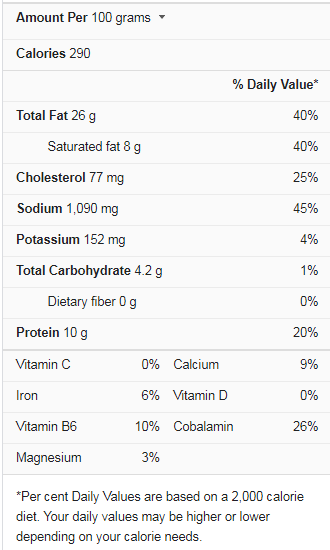If you want to know Hot Dog nutrition facts, you have come to the right site. Hot dogs can be healthful if they’re topped with healthy stuff. Hot dogs provide about 290 calories, 10 grams of protein, and nearly 4.2 carbohydrates per 100-gram serving. You may have heard that the nitrates needed to keep meat safe make hot dogs harmful. Nitrates, on the other hand, are found in nature. Spinach, celery, and beets have more nitrates than a hot dog! Nitrates are also thought to be beneficial to the heart.
One of the essential advantages of chowing down on that delicious hot dog is getting a lot of protein. One hundred grams of hot dog has approximately 10 grams of protein, roughly 15% of the daily required amount. Protein is required for your body to function correctly and be fit and healthy, and it is necessary for the development, repair, and maintenance of strong muscles.
Many vital minerals and micronutrients can be found in a hot dog. Selenium. The daily value (DV) for selenium is 11 percent in one hot dog. Selenium is a trace mineral that aids in the improvement of cognition, immunological function, and fertility.
Hot Dog Nutrition Facts
Protein
Protein-rich diets are suitable for children’s growth and prevent muscle loss as they get older. Protein also aids in the optimization of muscle training both during exercise and during the recuperation stage.
Yes, that delicious hot dog sizzling on your grill is packed with protein, and it contains all nine essential amino acids, which your body cannot create on its own.
Minerals Source
Zinc aids the immune system, metabolism, wound healing, and sense of taste and smell, and one hot dog provides 11 percent of your daily value.
Phosphorus (6 percent DV) is essential to develop strong, healthy bones and keeping your body healthy, and hot dogs are a good source of it. Potassium. Potassium (4 percent DV) regulates heartbeat, supports correct muscle and nerve function, and is necessary for all cells to function normally.
Iron in hot dogs supplies 4% of the daily value and is a vital nutrient that helps the body manufacture hormones and oxygen.
Copper, You’ll obtain 3% of your daily value for copper in one hot dog. This nutrient helps maintain healthy bones, blood vessels, and a robust immune system and partners with iron to make healthy red blood cells.
Unlike minerals found in grains and vegetables, animal nutrients are more “bioavailable,” meaning they are more easily absorbed and utilized by the body.
Vitamin B
Getting your Vitamin B12 from hot dogs is an excellent way to do so. A single hot dog can supply roughly 30% of your daily recommended amount.
Vitamin B12 is a set of vitamins necessary for proper metabolism, brain growth, and mental clarity. It also aids in the production of DNA and protects against megaloblastic anemia, a blood disorder that causes fatigue and weakness.
Calories
One hundred grams of hot dog has about 290 calories, less than ten percent of the daily calorie limit. You’ll be in the 300-350 calorie range if you pair it with a plain bun and condiments like ketchup, mustard, and relish.
Hot dogs contain much fewer calories than hamburgers. One hundred grams of a hot dog contains 290 calories, and a simple bread with a piece of cheese contains around 500 calories.
Hot Dog Health Benefits
Brain Health
Selenium is required for metabolism, reproduction, DNA synthesis, and protection against oxidative stress and infection. Selenium deficiency causes brain deterioration in the aged and an increased chance of cognitive decline. Fortunately, a single dog can provide about 11% of your necessary daily intake of this essential vitamin.
It is High In Energy Density
Do you have a lot of free time today? Meetings, deadlines, new possibilities, children, and examinations can quickly consume your time. Grab a hotdog and go on with your day if you need to eat on the move! Because a dog and bun include roughly 300 calories, consuming this meal can provide you with a much-needed energy boost. These vital calories will provide you with enough energy to get you through a long day.
It May Provide Iron
Iron is necessary for muscle metabolism because it assists red blood cells in transporting oxygen to all parts of the body. Anemia, which causes weakness, fatigue, immunological problems, gastrointestinal distress, and reduced cognitive function, is caused by an iron shortage.
Non-heme and heme are the two main types of iron. Non-heme is present in plant-based diets, whereas heme is found in animal goods like beef. That delicious beef hot dog brings you delight and helps you get your daily iron intake by giving roughly 4% of the daily value!
Gain Calories Quickly
A single hot dog contains fewer than 200 calories. However, you’re most likely eating it wrapped in a typical white refined flour hot dog bun, which adds about 100 calories and fiber (0.81g). This may not be welcome news to many. However, if you are a fussy eater or have difficulties consuming calories, hot dogs can help you quickly consume the calories you require.
What Is The Healthy Method To Enjoy A Hot Dog?
Some folks are completely opposed to anything involving a hot dog. There are, however, healthier methods to enjoy a hot dog that may persuade them to reconsider. You may be as creative as you want when customizing your hot dog to fit your diet. To wrap your hotdog, choose a whole wheat bun.
Look for organic beef that is low in salt on the label. Dress your dog with vegetables, onions, and tomatoes to increase nutrients. Sauerkraut is a fantastic addition to any dish. This fermented food is beneficial to the digestive system! Similarly, if you’re trying to lose weight, you might want to forego the cheese. If all else fails, you could always get a vegan hot dog!
Is Hot Dog Real Meat?
Then some disseminated internet tales that hot dogs were produced from lips, snouts, and floor clippings. Are they, however, accurate? We can be confident that our hot dogs are made of natural beef, hog, chicken, or turkey, thanks to the USDA’s hot dog food safety rules. Furthermore, due to American legislation, producing hot dogs from floor clippings is illegal, and government inspectors are stationed in every factory to ensure that only high-quality meat is utilized.
Is It Possible To Eat Hot Dogs As Part Of A Healthy Diet?
Hot dogs aren’t exactly healthy, even when consumed in moderation. According to the World Health Organization’s International Agency for Cancer Research (IARC), Ham, hot dogs, and other processed meats may contribute to colorectal cancer. Hot dogs are also heavy in salt and saturated fat.
A hot dog contains 7 grams of protein, or 15% of the daily value (DV), the amount of the nutrient your body needs. Protein is essential for the development, maintenance, and repair of solid muscles is especially beneficial for children’s growth, and prevents muscle loss that often occurs with aging.
Is It OK To Eat A Hot Dog Once In A While?
It’s OK if you enjoy a hot dog now and again. Everyone loves to eat exciting things, and it’s all part of the excitement of eating. It could have been better if you just ate the fruit salad.
However, nutritionists and dietitians say that an occasional frankfurter is acceptable if it is not a staple of your diet. After all, no other food product screams like processed pork and beef bands.
While consuming a lot of processed meats – the bacon, sausages, hot dogs, and ham that have officially been classified as cancer-causing substances by worldwide researchers – isn’t good for you, you’ll be fine if you do it in moderation, according to a nutrition specialist at Georgia State University.
How Many Hot Dogs Can You Eat?
The T.H. Chan School of Public Health at Harvard University. Consuming processed meat like a hot dog in moderation isn’t harmful to your health, but keep it once or twice a month. If you eat one every day, you’re at a greater risk of developing heart disease and cancerHot dogs, like many processed portions of meat, have been associated with an elevated risk of type 2 diabetes, cardiovascular disease, cancer, and mortality.
According to a study of 1,660 people’s diets, the amount of processed meat ingested increases the risk of bladder cancer. Smoliga, a veterinarian and exercise scientist, has been working on a mathematical estimate of the potential maximum number of hot dogs a human might ingest in 10 minutes. “The answer is 83,” said Dr. Smoliga, a North Carolina’s High Point University professor.
Can You Eat Hot Dogs For Breakfast?
We all took a mouthful and let out a collective “dayuuuum” because breakfast hot dogs are, without a doubt, excellent. So, everyone, have a wonderful National Hot Dog Day. There’s no such thing as a wrong time to eat a hot dog.
Even though some people were offended by the idea, 37 percent of the 111 people polled indicated they had eaten hot dogs for breakfast. While a handful of my friends like hot dogs and eat them at any time of day, I also discovered that they are typical breakfast items in Mexican and Filipino cuisines.
The Hot Texas Wiener is an all-beef hot dog that has been “blanched” or par-cooked in 350-degree vegetable oil in a fry basket for a few minutes, then cooked in a tilted steel pan in another hot vegetable oil bath until done, and then placed in a bun, topped (in strict order) with spicy, ballpark-style ketchup.
Conclusion
Their names commonly refer to the dish these sausages are served. A hot dog is considered a sandwich by some. The way hot dogs are prepared and the condiments used vary by country. Typical condiments include mustard, ketchup, mayonnaise, relish, and cheese sauce.
Garnishes include onions, sauerkraut, jalapenos, chile, shredded cheddar, coleslaw, bacon, and olives. Hot dog varieties include corn dogs and pigs in a blanket. The Oscar Mayer Wienermobile and Nathan’s Hot Dog Eating Contest are two cultural icons of the hot dog.


